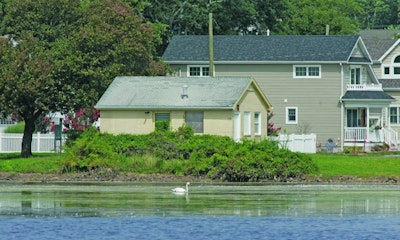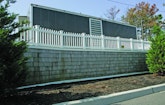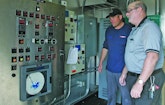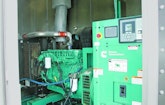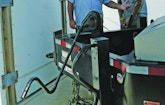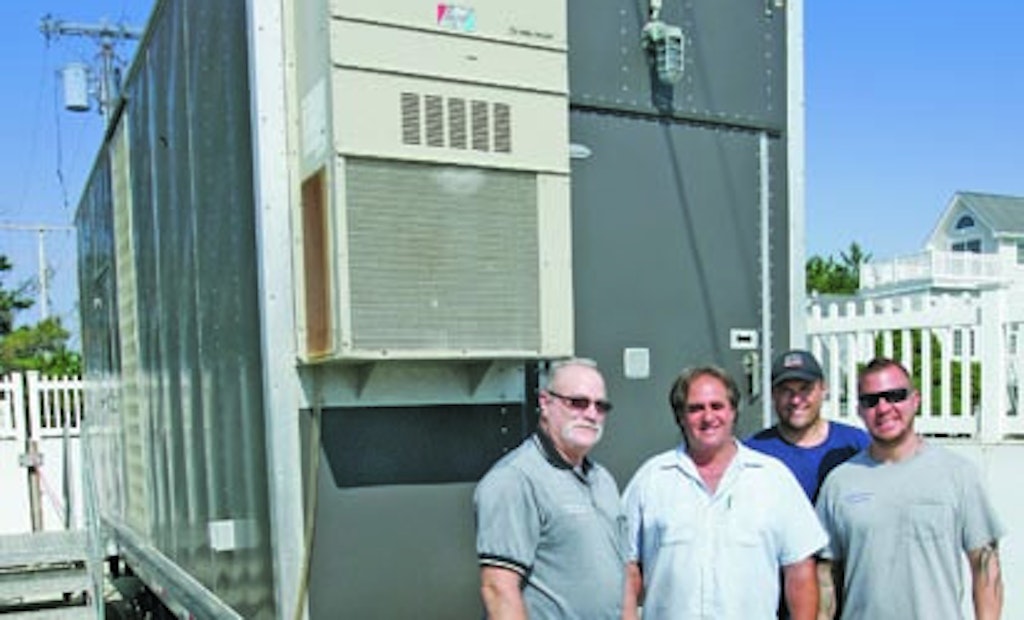
Interested in Infrastructure?
Get Infrastructure articles, news and videos right in your inbox! Sign up now.
Infrastructure + Get AlertsOctober 2012 marked the East Coast passage of Superstorm Sandy, the second-most costly hurricane in United States history. Not content to simply weather future storms, New Jersey’s South Monmouth Regional Sewerage Authority (SMRSA) has thrown its rough weather action plan into high gear. The authority is converting a series of pumping stations into mobile units, which can be transported inland at a moment’s notice.
“We’re not the biggest utility in the state, but pound for pound, South Monmouth was hit as hard by Superstorm Sandy as any utility in New Jersey,” says Michael Ruppel, executive director of the SMRSA. “Sandy not only tested our infrastructure, it tested every emergency response plan we’d been working on for 20 years or more.”
The underpinning for that planning began with the establishment of the SMRSA in 1977 by eight municipalities joining forces to meet the requirements of the federal Clean Water Act. The boroughs of Belmar, Brielle, Lake Como, Manasquan, Sea Girt, Spring Lake, Spring Lake Heights and the Township of Wall are all located about an hour’s drive south of Newark along the Atlantic coast. Five of the communities had a pre-existing primary treatment facility, but sludges were still discharged into the Atlantic.
Protecting the Atlantic
Today, the authority operates a state-of-the-art 9.1 mgd wastewater treatment plant, located in Belmar. A single force main of about 12 miles in length conveys wastewater from each member community across the flat coastal terrain to the communal treatment plant. The main is mounted at about 12 feet above sea level and ranges from 16 to 36 inches in diameter. Construction materials include ductile iron and prestressed concrete.
“The majority of it was built in the 1970s and utilizes some of the original pipeline infrastructure, which was close to 100 years old,” says Ruppel. “We have two programs to proactively monitor pipe integrity – by monitoring pressure and by actually cutting coupons from the pipe wall to determine life expectancy of that section of pipe.”
The utility employs eMaint by CMMS to develop cost-effective maintenance programs on all infrastructure assets.
“We strive to do as much as we can in house with our very capable staff,” says Ruppel. “We do some electrical work, pipe maintenance, work on concrete walls and pump replacements, but we leave larger construction projects to outside contractors.”
The authority has formally practiced asset management since 1991 and has either renewed, restored or replaced 80 percent of its assets since then.
While the force main remains in good overall condition, an assessment of sewer lines belonging to member communities circa 2000 revealed that aging infrastructure, also up to a century old, was leading to severe inflow and infiltration. An active program sponsored by SMRSA over the following five years resulted in a dramatic reduction in annual total flow. It also increased the authority’s capacity for handling peak flows during severe wet-weather events.
Climate drives projects
“Where climate change once used to be one of the factors in our planning, it now drives the projects,” says Ruppel. “We’ve experienced four severe wet-weather incidents in the past six years, three of which were declared national disasters. These hurricanes and northeasters have caused power outages and caused flooding in low-lying areas. At some pumping stations we’ve suffered damage that far exceeded the original value of the asset. Our biggest challenge is to build systems that provide resiliency and control damage while maintaining service in a cost-effective manner.”
The concept for the mobile pumping station was born on the back of a napkin in 2006, long before Sandy, says Ruppel. The Sea Girt Avenue Pump Station, a former sewage treatment plant, had reached the end of its useful service life due to age, the inability to obtain spare parts and above-grade deterioration. The station had been flooded and damaged by earlier storms and flood protection was a key factor in redesigning the facility.
“We couldn’t continue to throw money into building infrastructure that would continue to be subject to flooding,” says Ruppel. “I’d worked for the Department of Defense where mobile missile launching stations were effective in all types of terrain and topography, so we engaged engineering firm CME Associates to conceptualize a project that would reconstruct the pumping station to be – as much as possible – hurricane proof.”
The difficulty of obtaining land-use permits, coupled with high construction costs, closed the door on moving the station. Instead, the existing below-grade wet well and dry well would be reused as part of a rehabilitated mobile facility.
Think mobile
The new design specified communication equipment, pumps, valves, comminutors and their motors, piping and a flowmeter, all rated for immersion duty. All other equipment including controls, SCADA equipment, alarm systems, variable-speed drives and an emergency generator would be located in a mobile trailer enclosure above the level of initial flooding. A series of detachable cables and plugs would connect the two units.
“When we see the potential for a major storm event, we send in a truck, put wheels on the mobile trailer, disconnect the plugs and cables and move the enclosure to high ground about a mile and a half inland,” says Ruppel. “In its place we would leave a sacrificial portable generator and transfer switch worth $30,000 to $40,000. A secondary, sacrificial electrical and control system, permanently mounted at the site, would operate the system either on utility or generator power. The portable generator might survive the storm, but if it doesn’t we’ve saved a trailer-load of equipment worth a half-million dollars.”
Construction of the new mobile station was completed in July 2011 by Baltimore-based trailer manufacturer Pritchard Brown. Within 30 days, the coast was ravaged by Hurricane Irene. Planning and training paid off: The operation took two utility workers fewer than three hours to complete.
SMRSA’s design was awarded a 2012 Association of Environmental Authorities WAVE Award in the Forward Thinking category.
Sandy does its worst
The far more severe Superstorm Sandy arrived the following October.
“It was worse than we could have imagined,” says Ruppel. “We had approximately $10 million in instantaneous damage, 10 of 11 pumping stations out of service and 70 percent of them submerged. We were running pumping stations on auxiliary power, but the storm surge knocked out the local water utility. We need potable water to cool the generators, so they shut themselves down at two pumping stations. That’s something we will make provisions for in the future.”
The one station that remained operational: Sea Girt Avenue. All told, the mobile enclosure at the Sea Girt Pump Station saved the authority an estimated $1.5 million in avoided damage due to hurricanes Irene and Sandy.
By day two, SMRSA crews had nine of 11 pumping stations operational. Two facilities close to shore were inaccessible, swamped by a storm surge that dumped 7 feet of water and tons of sand over sea walls and into low-lying areas. Crews also amassed the authority’s mobile pump arsenal, mostly Godwins, to pump out Lake Como and relieve the flooding at the Lake Como Pump Station.
Following the storm, the authority presented a case to the Federal Emergency Management Agency (FEMA) that construction funds should be committed to rebuilding the Pitney Avenue Pump Station as a mobile enclosure. FEMA approved the request as a “least cost alternative project.”
“Not only is the mobile design more resilient to storms, but it’s also less expensive to build,” Ruppel says. “Retrofitting the existing station would have cost $640,000. The mobile enclosure, complete with a 0.5 mgd pump, was $455,000 delivered.”
The construction contract was once again awarded to Pritchard Brown.
While the Lake Como Pump Station will be rebuilt on higher ground, plans are in the works to replace the heavily damaged Belmar Pump Station with a third mobile station.
Mobile best practices
FEMA has since included specifications for the mobile pump station design among its nationwide Best Management Practices for mitigation of damages during a flood event.
While the units don’t look like a traditional pump station, they can better survive a major storm and they are taking on a more traditional look.
“Some community members were accustomed to a block building surrounded by trees,” Ruppel says. “Although we made efforts to make the first-generation mobile enclosure fit in with local aesthetics, it was too different for them. Mobile enclosure 2.0 features more windows and shutters and more elaborate landscaping.”
The authority’s projections for future storm events indicates that Monmouth County will continue to face more severe and more frequent climate challenges.
“Our people came through Superstorm Sandy with a gold star,” Ruppel says. “Adopting the remote pumping station concept should provide our agency with enough resilience to survive the next storm in even better shape.”
More Information
Godwin, a Xylem brand - 800/247-8674 - www.godwinpumps.com
